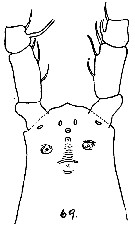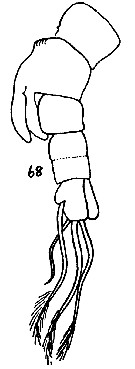|
|
 |
Fiche d'espèce de Copépode |
|
|
Monstrilloida ( Ordre ) |
|
|
|
Monstrillidae ( Famille ) |
|
|
|
Monstrilla ( Genre ) |
|
|
| |
Monstrilla bernardensis (Willey, 1920) (M) | |
| | | | | | | Syn.: | Thaumaleus bernardensis Willey, 1920 a (p.43, Descr.M, figs.M); Shih & al., 1971 (p.215); no Davis & Green, 1974 (p.61, figs.M, Rem.) | | | | Ref.: | | | Grygier, 1995 a (p.42, 61) |  issued from : A. Willey in Rep. Can. Arct. Exp. 1913-18, 1920, VII, Part K. [p.44K, Fig.69]. As Thaumaleus bernardensis. Male (from Bernard Harbor): 69, head (ventral side). Nota: Head and 1st thoracic segment fused to form a cephalothoracic segment which only slightly exceeds the next three segments. The lengths of A1, of the cephalothorax, and of the three free pedigerous thoracic segments combined, are subequal, proportions being 55 : 56 : 53. The hind-body, comprising the apodous 5th segment (Th5), the genital segment, two following segments and the furca (= caudal rami), has the relative length represented by the number 35. Thus the forebody is approximately 3 times the length of hind-body. The distance between the frontal margin and the mouth cone is less than 1/3 of the distance of the latter from the hinder margin of the cephalothoracic segment. On the ventral side of the head there are several chitinous structures intervening between the anterior A1 and the rudimentary mouth-cone. In front of the latter the cuticle is wrinkled, and the wrinkles terminate in a small papilla which may represent a rudimentary (vestigial) labrum. In front of this there is another median papilla (of uncertain significance), and before this again a pair of clear oval areas. At the base of each anterior A1 there is a small transversely elongate chitinous thickening. On either side of the supposed labrum there is a wrinkled papilla showing a small central cavity (possible vestiges of A2). A1 5-segmented with proportions 8 : 10 : 5 : 15 : 16. The 5th segment carries a strong, terminal cla-like seta, which can be held forwards or bent at a right angle to the segment.. 1st segment with a subulate seta with short plumes ; 2nd segment with 5 shortly plumose subulate setae, of which 3 are to be seen at the margin, and in addition a long plumose seta arising dorsally at the distal margin, whose long plumes occur on the slender distal portion of it. ; 3rd segment with 2 long plumose setae and a shorter subulate seta beset with fine points ; 4th segment with 7 setae, including a slender aesthetask or sensory filament and 1 long plumose seta, proximad are 2 marginal subulate setae of which the proximal one is the longer ; removed from the margin a litthe in fronf of the proximal subulate seta and proximad of the base of the long set ais the aesthetask ; 5th segment with 3 branched setae, a long plumose seta, 4 soft slender setae which look like aesthetasks, a marginal and a subterminal subulate seta and the terminal claw, making 11 altogether. Swimming legs all alike, both rami 3-segmented. Exopodal segments with 1, 0, 1 outer seta ; 1, 1, 4 inner setae ; 1 terminal seta (plumose like the others). Endopodal segments with 1, 1, 5 setae. Basis with outer seta quite small and slender, longer on P3.
|
 issued from : A. Willey in Rep. Can. Arct. Exp. 1913-18, 1920, VII, Part K. [p.45K, Fig.70]. As Thaumaleus bernardensis. Male: 70, terminal portion of left A1 (only the promary bifurcation of the branched setae is shown).
|
 issued from : A. Willey in Rep. Can. Arct. Exp. 1913-18, 1920, VII, Part K. [p.43K, Fig.68]. As Thaumaleus bernardensis. Male: 68, hind body. Anal segment shows superficial indication of an imperfect division into two segments. Counting it as one segment, the caudal furca is a little shorter, in the ratio of 7 to nearly 8. There is a very small papilla on the ventral side of Th5, representing a rudiment of P5. The ventral lobes of the genital segment have the proportions shown in the figure (Fig.68). Each caudal ramus carries 4 setae, the most ventral one being being much shorter than the others.
| | | | | Ref. compl.: | | | Bernier & al., 2002 (p.651, tab.1) | | | | NZ: | 1 | | |
|
Carte de distribution de Monstrilla bernardensis par zones géographiques
|
| | | | Loc: | | | Arct. (Canada: Bernard Harbour) | | | | N: | 1 | | | | Lg.: | | | (190) M: 1,9-2,4; {M: 1,9-2,4} | | | Dernière mise à jour : 20/01/2015 | |
|
|
 Toute utilisation de ce site pour une publication sera mentionnée avec la référence suivante : Toute utilisation de ce site pour une publication sera mentionnée avec la référence suivante :
Razouls C., Desreumaux N., Kouwenberg J. et de Bovée F., 2005-2025. - Biodiversité des Copépodes planctoniques marins (morphologie, répartition géographique et données biologiques). Sorbonne Université, CNRS. Disponible sur http://copepodes.obs-banyuls.fr [Accédé le 24 décembre 2025] © copyright 2005-2025 Sorbonne Université, CNRS
|
|
 |
 |






